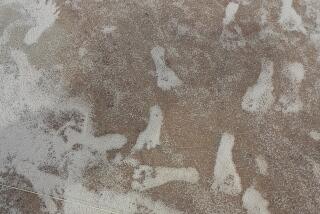‘Foodprints’ help reveal what our ancestors ate
If the eyes are the romantic’s window to the soul, then teeth are the anthropologist’s trick door to the stomach.
Scientists have relied on the size and shape of teeth and skulls to figure out what our early human ancestors ate on a regular basis; certain teeth appear ideal for grinding nuts and seeds, while others seem to have evolved for slicing meat or leaves. Now two researchers have taken this approach a step further, examining the microscopic wear and tear on individual teeth to see what different hominins, like members of Australopithecus, Paranthropus and our own genus, Homo, were really munching on. Think of these markings as “foodprints” that reveal evidence of an individual’s last few meals.
As it turns out, many of these early human ancestors bit off a lot more than we thought they could chew. Paleoanthropologist Peter Ungar of the University of Arkansas explains the work he did with Matt Sponheimer of the University of Colorado at Boulder, which was published this month in the journal Science.
What was the goal of your research?
We’re trying to understand the ecology of human ancestors: what they did for a living, how they interacted with their environment. We wanted to know what the actual behavior of our ancestors was.
Traditionally what people have done is they’ve looked at the sizes and shapes and the structure of the teeth and the skull. And they say, “Aha! Based on what the skulls look like and teeth look like, that was a meat-eater.” But that doesn’t really tell you what they actually ate — that tells you what they could have eaten. So if you have big flat teeth, they might be good for crushing nuts and seeds. If you have hard, sharp teeth, they might be good for cutting meat and leaves into slices.
But then we looked at the microscopic wear on the teeth. It’s like a footprint — certain foods cause scratches, certain foods cause pits. The pattern of wear tells you about the foods.
Then we look at the chemistry of the teeth — in particular the carbon — which is the result of the foods you eat. Different kinds of foods have different kinds of carbon. For example, if you look at grasses — tropical grasses and sedges have one kind of carbon, but trees and bushes have a different kind of carbon because they each have a different kind of photosynthesis.
Which species’ diets were the most surprising?
The best example is not with a direct human ancestor but one of our near cousins, called Paranthropus. There are different species of Paranthropus, and we looked at two of them: one from southern Africa and one from eastern Africa. Like us, they walked on two legs when on the ground, and their brains were a bit larger than chimpanzees’. We used to believe they were dietary specialists because they had big crests on their skulls, which would have anchored large chewing muscles, and big teeth. We thought these animals ate nuts, fruits and seeds.
So for the microscopic wear on the teeth, if these were hard-object specialists their teeth should be pitted-up like the moon. Also, their carbon should be a particular type that typically comes from tree products, such as nuts and seeds.
But when we looked at eastern African Paranthropus, it was nothing like that. The teeth had a different kind of carbon, and they were loaded with scratches, not pits. It looks like they were specializing on grass, not nuts and fruit seeds. So it was the exact opposite of what we expected to find.
But it gets even more interesting, because in southern Africa this species seems to have done something different.
Many living primates will eat soft, fleshy, sugary fruits, which occasionally won’t be available during the lean months. In the dry season, they may have to fall back on hard, brittle things or tough, low-energy things. That’s what the southern African species was probably doing. They really were overbuilt for most of the time. If you eat jelly 360 days out of the year but rocks for the other five days out of the year, your teeth still better be designed to eat rocks.
The two species’ anatomies are nearly identical. And in neither case are those diets what we expected based on anatomy. The story is much more complicated.
How will this change the way we study ancient diets?
It’s a completely new and different way of looking at these things. It’s thinking about ecology rather than old dry bones — thinking about the animals as they were in life.
We’re no longer saying, “Dinosaurs, ah, that was clearly a meat-eater” — there’s a way to test that now. We can look at the teeth and see if that’s the case.
This tells us what different species were eating. So can this reveal what the environment looked like back then?
Absolutely. Sponheimer and I have been working on rodents — they’re great at fossil human sites because they live in a small area and their diets are very influenced by their environments. So if a bunch of rodents are loaded up on the kind of carbon in tropical grasses and they’re in the same place as a human ancestor, we know that human ancestor lived in a tropical grassland.
This interview was edited for space and clarity.







